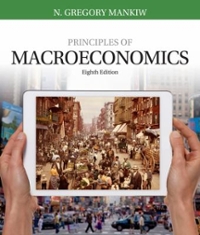Question
Comment discussion below and answer the questions in an extensive and detailed way The article/report selected for the Week 3 Discussion: Title: CRS Report R47115,
Comment discussion below and answer the questions in an extensive and detailed way
The article/report selected for the Week 3 Discussion:
Title: CRS Report R47115, U.S. economic recovery in the wake of COVID-19: successes and challenges.
This is a Congressional Research Services report from May 31, 2022.
Authors: Marc Labonte,Specialist in Macroeconomic Policy and Lida R. Weinstock, Analyst in Macroeconomic Policy
Source:Labonte, M., & Weinstock, L. R. (2022). U.S. economic recovery in the wake of COVID-19: successes and challenges / Marc Labonte, Lida R. Weinstock. ([Library of Congress public edition].). Congressional Research Service.
Link: 1 (congress.gov)Links to an external site.
Recommendation: Please base your reflection and discussion on the pre-report summary and the first 7 pages (through Supply Disruptions), along with Appendix A (Understanding the Economy Under COVID-19 in a Supply and Demand Framework) including Figure A-1 and Figure A-2.
Summary
The Congressional Research Service (CRS) engages experts to approach and research topics to analyze current affairs which can then be used to inform congressional decision-making. This is a report (R47115) published in May 2022.
The model of aggregate supply and aggregate demand provides a framework for studying economic fluctuations. Aggregate demand is the relationship between demand in the quantity of output and the price level. Aggregate supply is the relationship between the quantity of goods and services and the price level. Due to COVID-19 the United States experienced changes to the aggregate demand and aggregate supply relationship. CRS Report R47115 provides details of the initial effect of the pandemic, but goes on to provide further information than in our text on how the economy is recovering.
Initially, the pandemic resulted in declines in production and spending. Businesses closed, workers went home (and worked at home if they could) or were laid off, production slowed, spending decreased (minimal sporting or musical events with audiences), labor needs lessened while technology surged. The pandemic created an economic shock, defined as sudden impact to variables such as unemployment, inflation, or consumption. The article states that GDP declined at an annual rate of 31.2% in 2020 Q2. Figure A-1 shows the decline in aggregate demand and aggregate supply.
Over time, the growth began to resolve, as suggested by a GDP growth at 2.3% in 2021 Q3. The article reviews trends in personal consumption, investment, and government spending. Figure A-2 shows that the economy has not returned to the pre-pandemic level (as of the May 2022 publication), but has shifted due to the impact stimulus creating a higher GDP. Recovery of supply lagged demand which drove higher inflation.
Connection to Class
I chose this format, a CRS report, as well as the topic of the COVID-19 pandemic for a couple of reasons. Together, we have lived through this period of time, so we can draw on day-to-day and month-to-month experiences and relate some of our personal experience and understanding to the macroeconomic concept of aggregate supply and demand. Personally, I am quite well educated in the biological sciences, and although engaging, macroeconomic concepts force me to think about a large basket of goods and supply and demand as a very different field of study. I hope that you find, as I did, that the CRS report presents a very logical progression of information that describes the decline and recovery in output, changes in consumer demand, and changes in consumption (spending and saving). The CRS report is long and includes significant sections on monetary policy, so please note the recommended pages that are listed above.
I also hope that the CRS report enhances what you read in Chapter 11, which is assigned with the third-week module. Section 11-6 gives a description of the macroeconomic impact of the pandemic since the book went to press in 2020 and the pandemic was still in full force at that time. The CRS report was published in May 2022, so it is able to give a more detailed analysis of the economic response post-pandemic.
Discussion Questions
I am hoping to join in the learning as we explore the questions below this week. I don't expect each of you to respond to each question. I'd encourage you to pick one or two questions and explore them with a thoughtful response. I hope that as a group we can join in a few different strings of conversations related to these questions.
- The NBER reported that the economy experienced a recession in March and April of 2020. A macroeconomic expansion was initiated by the issuing of a stimulus. In general, would you say that this incentive to spend resulted in a positive change in GDP (income, output) that the model would predict? Why or why not? Think about a demand shock vs a supply shock.
- Apply the equation AE=C+I+G to think about the following: If the government invests significant dollars in firms to develop a successful vaccine, what component in this equation changes? What is the effect? Are dollars that are spent to make a vaccine considered investment, or government spending, or is it a combination?
- Reflect on Appendix A and Figure A-1. Perhaps just a "fun" question to think about ... Can (should) the model of aggregate demand and aggregate supply be used to explain why the population hoarded bleach and toilet paper? Why or Why not?
- What are some of the key variables that contributed to the improvements in output since the March and April 2020 recession? What changes occurred to turn the shift in the demand or supply curve towards pre-pandemic rates?
Step by Step Solution
There are 3 Steps involved in it
Step: 1

Get Instant Access to Expert-Tailored Solutions
See step-by-step solutions with expert insights and AI powered tools for academic success
Step: 2

Step: 3

Ace Your Homework with AI
Get the answers you need in no time with our AI-driven, step-by-step assistance
Get Started


